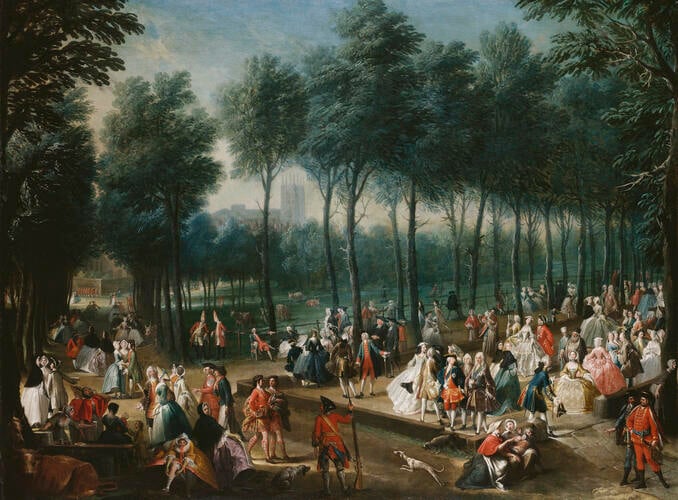-
1 of 253523 objects
St James's Park and the Mall c. 1745
Oil on canvas | 103.5 x 138.5 cm (support, canvas/panel/stretcher external) | RCIN 405954
-
St James’s Park was laid out by Charles II in the formal French style with avenues of trees and a long rectangular canal. This scene is viewed looking back towards Whitehall Palace down the oblique avenue of trees. Westminster Abbey is visible in the distance including Hawksmoor’s façade towers completed in 1745. To the right of this painting is the quadruple avenue of trees with a wide aperture down the middle, containing a surface of crushed cockle-shells. This was originally created (though at this date no longer used) for a game resembling croquet, called pall-mall, which was why this road was called ‘the Mall’, a name it retains today.
This royal park was kept open for the public, though chairs, horses and carriages were forbidden except by special by permission of the King. It became a favourite resort for all fashionable (and not so fashionable) society, the Mall in particular being a place to be seen in the eighteenth-century London equivalent of the passeggiata. According to a French visitor:
‘Society comes to walk here [along the Mall] on fine, warm days, from seven to ten in the evening, and in winter from one to three o’clock . . . the park is so crowded at times that you cannot help touching your neighbour. Some people come to see, some to be seen, and others to seek their fortunes; for many priestesses of Venus are abroad . . . all on the look out for adventures.’ (César de Saussure, Letters from London, 1725-30)
Other accounts tell of cows and deer in the fields around the park, while a visitor in 1765 especially appreciated the availability of udder-fresh cow’s milk ‘served with all the cleanliness peculiar to the English, in little mugs at a penny a mug’ (P.-J. Grosley, A Tour of London, 1772) and seen here in the lower left-hand corner.
The purpose of an image like this is people-watching: contemporaries would clearly have recognised familiar scenes (like the milk-bar) and recognisable types, within the extraordinary variety of the London crowd. The low-life characters are kept somewhat to the periphery of the image: the woman pulling up her stocking on the left foreground and the suckling mother on the right. Three different regiments are represented: two soldiers from a ‘Grenadier Company’ of a Guards or Line regiment with their high mitres chat in the centre background; two Hungarian Officers, the one in scarlet probably a Nádasdy Hussar, appear at the lower right — Austria was Britain’s ally during the war of the Austrian Succession (1740-48); two Highland Officers in government tartan stride across the centre just in front of a foot-soldier. The 1747 Act of Proscription outlawed the wearing of Highland dress for male civilians after that date, although it continued to be worn by men like these, serving in Highland regiments in the British Army. Immediately behind the Scottish soldiers is a sailor, talking to a friend while a well-dressed black woman walks in front. Two priests in black walk in the centre right, while further to the right an exotic-looking robed and bearded middle-eastern elder instructs a younger man. Otherwise, the Mall itself is given over to the beau monde, dressed in the height of fashion and saluting each other with elaborate grace and courtesy.
This group is dominated by the clearly-identifiable figure of Frederick, Prince of Wales, speaking to a fellow Garter Knight in the centre of the composition. Immediately behind the viewpoint of the picture was the gate leading to the Prince’s garden at Carlton House, so he is literally on his own doorstep. Royalty had mingled with the public in this setting at least since the time of Charles II, but Frederick’s presence here is a perfect expression of his common touch - or his nauseating habit of ingratiation depending upon your point of view.
Text adapted from The Conversation Piece: Scenes of fashionable life, London, 2009Provenance
Acquired by George IV in 1808 as Hogarth; recorded in the Blue Velvet Closet at Carlton House in 1819 (no 57)
-
Creator(s)
Acquirer(s)
-
Medium and techniques
Oil on canvas
Measurements
103.5 x 138.5 cm (support, canvas/panel/stretcher external)
119.5 x 154.1 x 7.5 cm (frame, external)
Category
Object type(s)
Other number(s)
Alternative title(s)
The Mall and St James's Park, previously entitled
